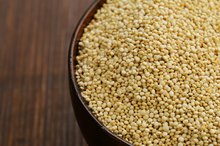What does fact checked mean?
At Healthfully, we strive to deliver objective content that is accurate and up-to-date. Our team periodically reviews articles in order to ensure content quality. The sources cited below consist of evidence from peer-reviewed journals, prominent medical organizations, academic associations, and government data.
The information contained on this site is for informational purposes only, and should not be used as a substitute for the advice of a professional health care provider. Please check with the appropriate physician regarding health questions and concerns. Although we strive to deliver accurate and up-to-date information, no guarantee to that effect is made.
An Allergy to Wheat With Swollen Eyes
An allergy to wheat involves an abnormal immune system response that occurs as a result of consuming any food that contains any of the proteins found in wheat, which include gluten, albumin, globulin and gliadin 1. After ingestion of one of these wheat proteins, an allergic individual experiences a variety of physical symptoms, including, but not limited to, swollen eyes. According to the Food Allergy Initiative, a wheat allergy usually affects young children and, in most cases, is outgrown by the age of 3 1.
Physiology
When someone with a wheat allergy consumes any of the four wheat proteins for the first time, the body triggers an immune system response that involves the production of an antibody 1. In most individuals, antibodies are produced as a result of the invasion of harmful substances, such as bacteria or viruses. Once the antibody is produced, any recurring exposure to the wheat proteins will trigger the release of the antibodies as well as the release of the chemical substance histamine. Histamine triggers a widespread inflammation response that is intended to protect the body from harm. The inflammation response often affects the face and is the reason why many people with a wheat allergy experience swollen eyes after the consumption of wheat 1.
Symptoms
Wheat & Severe Stomach Pain
Learn More
In addition to swelling, the eyes may also become itchy, watery and red. The mouth and throat may also become swollen and itchy as well, which can result in difficulty breathing. Hives may develop, along with abdominal cramps, nausea and vomiting. Anaphylaxis, which is a life-threatening allergic reaction, may occur in those with severe wheat allergies. Anaphylaxis involves severe throat swelling, chest pain, difficulty swallowing, pale or blue skin, dizziness, fainting and weak pulse, according to MayoClinic.com 1.cause:
- Anaphylaxis involves severe throat swelling
- chest pain
- difficulty swallowing
- pale or blue skin
- dizziness
- fainting
- weak pulse
- according to MayoClinic.com 1
- In addition to swelling, the eyes may also become itchy, watery and red.
- The mouth and throat may also become swollen and itchy as well, which can result in difficulty breathing.
Treatment
The only to treat a wheat allergy is to avoid consuming foods that contain any of the wheat proteins 1. The symptoms of a minor allergic reaction can be alleviated with the use of over-the-counter antihistamines. These medications contain a substance that blocks the action of histamine, which will reduce the swollen eyes as well as other symptoms. Anaphylaxis may require the administration of an epinephrine shot.
- The only to treat a wheat allergy is to avoid consuming foods that contain any of the wheat proteins 1.
- These medications contain a substance that blocks the action of histamine, which will reduce the swollen eyes as well as other symptoms.
What to Avoid
Signs & Symptoms of Wheat & Whole Grain Allergies
Learn More
To prevent an allergic reaction, it is important to avoid foods that contain wheat. Often, food labels will list ingredients that are unfamiliar to you. Many of these ingredients contain wheat. The Lucile Packard Children’s Hospital at Stanford provides a list of some unfamiliar food ingredients that contain wheat. These items include:
- bran
- bulgur
- cereal extract
- couscous
- durum
- einkorn
- emmer
- farina
- gluten
- spelt
- To prevent an allergic reaction, it is important to avoid foods that contain wheat.
- The Lucile Packard Children’s Hospital at Stanford provides a list of some unfamiliar food ingredients that contain wheat.
Considerations
A wheat allergy differs from the food intolerance celiac disease, which is characterized by an intolerance to gluten 1. Celiac disease is categorized as a digestive disorder and mainly affects the small intestine, rather than the immune system.
Related Articles
References
- MayoClinic.com: Wheat Allergy
- Cianferoni A. Wheat allergy: diagnosis and management. J Asthma Allergy. 2016;9:13-25. doi:10.2147/JAA.S81550
- Salcedo G, Quirce S, Diaz-perales A. Wheat allergens associated with Baker's asthma. J Investig Allergol Clin Immunol. 2011;21(2):81-92.
- Scherf KA, Brockow K, Biedermann T, Koehler P, Wieser H. Wheat-dependent exercise-induced anaphylaxis. Clin Exp Allergy. 2016;46(1):10-20. doi:10.1111/cea.12640
- Pacharn P, Vichyanond P. Immunotherapy for IgE-mediated wheat allergy. Hum Vaccin Immunother. 2017;13(10):2462-2466. doi:10.1080/21645515.2017.1356499
- Czaja-Bulsa G, Bulsa M.What Do We Know Now about IgE-Mediated Wheat Allergy in Children?Nutrients. 2017 Jan 4;9(1). pii: E35. doi: 10.3390/nu9010035.
- Pacharn P, Vichyanond P.Immunotherapy for IgE-mediated wheat allergy.Hum Vaccin Immunother. 2017 Oct 3;13(10):2462-2466. doi: 10.1080/21645515.2017.1356499.
Writer Bio
Lindsay Boyers has a Bachelor of Science in nutrition from Framingham State College and a certificate in holistic nutrition from the American College of Healthcare Sciences. She is also a licensed aesthetician with advanced training in skincare and makeup. She plans to continue on with her education, complete a master's degree program in nutrition and, ultimately, become a registered dietitian.









